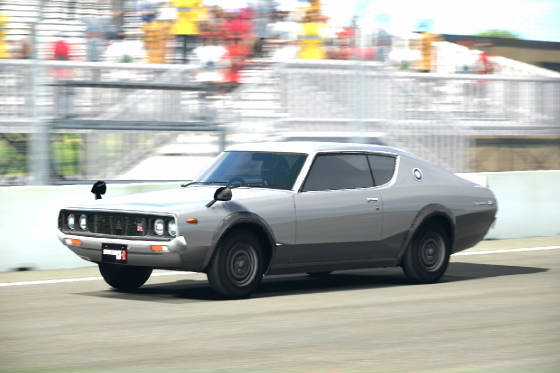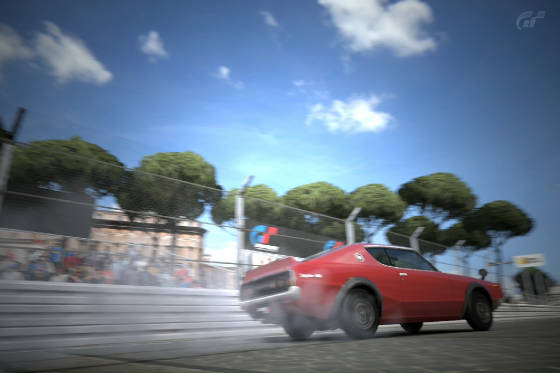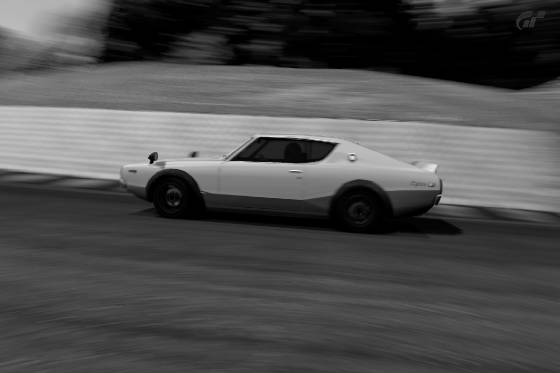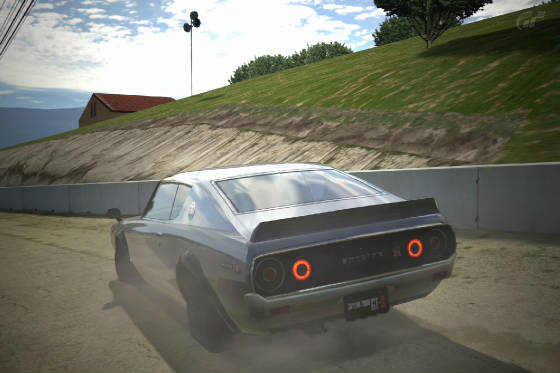|
SPECS Year: 1973 Type: hardtop coupe Class: Compact Country of Origin: Japan Host: GT5 Price: not available on test car. Was 56,582 cr. for a model with 48,216.8 miles on its odometer Mileage: 0.0 Length: 183.5" // Width: 66.75" // Height: 54.33" Wheelbase: 102.75" Overhang: 6 feet 4 inches Track: 54.9" [F] 54.1" [R] Ground
Clearance: N/A Weight: 2,523 pounds Layout: Front Engine / Rear-Drive Tires: 175/HR-14 F. Suspension: struts, coils, lower wishbones, anti-roll bar R. Suspension: semi-trailing arms, coils, shox, anti-roll bar Brakes: vented discs
/ discs This car was given oil change, but no engine
rebuild, for all specs & testing below Engine:
2.0 liter DOHC inline-6 Aspiration: normal Fuel Syst:
three single-barrel carbs Bore x Stroke: 3.23 x 2.47" Compression:
9.00:1 Idle: 750 // Redline: 7,500 // RPM Limit: 8,000 Tstd Horsepower: 155 @ 7,000 RPM Tested
Torque: 124 @ 5,500 RPM Credits / HP: $365.04 Pounds / HP: 16.28 Pounds
/ Trq: 19.87 Hrspwr / Liter: 77.9 Transmission:
5-speed manual Differential: ? Probably limited-slip (previous generation had one) 0-60 mph: 9.000 0-100 mph: 23.842 0-400 M: 17.222 @ 86 mph 0-1 Kilom: 30.680 @ 110 mph 1 Mile: 42.329 @ 121 mph Daytona Lap: 1:08.450 Top Gear RPM @ 60 mph:
3,150 100- zero mph: 6.133 seconds Top Speed on Redline 1st: 42.0 mph 2nd: 62.8 3rd: 91.0 4th: 120.6 5th: 135.7 mph @ 7,250
rpm

-----------EXTERIOR / HISTORY-------------
Bang! Finally. Here it is folks, the first
all-new Nissan Skyline review on this site in over a year. Actually, make that two years. The 1973 Skyline GT-R (codenamed
KGC111) came from the GT-R's second generation of cars, but was from the fourth overall generation of Skylines. The '73 GT-R would
not last very long, unfortunately, hence this review should be a quick read. In 1973 the
Skyline was at its peak, so far as style and expectations went. This is the most stylish early Skyline of all in our
games (not including the '62 Prince), and because of the Skyline's racing reputation, the public must have been going
mad to see what Nissan (and Prince) would come up with next. Nissan had managed to 'think away from the box', so to speak,
getting away from the KPGC110's boxy exterior, trading it for smoother angles, and an overall rounder shape. After the '73
GT-R, the next GT-R making its appearance would also be boxy, but this wouldn't happen for quite some time. The '73 took styling cues from America's muscle of the times. Quad headlights are slightly hidden under the hood,
similar to Dodge's Challenger and Plymouth's Barracuda. Each wheel-well has black trim accenting around the tires, there are
touches of chrome here and there, and the rear's got a small, probably useless spoiler on its trunk. Nissan chose a fastback
body shape, aping America's Torinos, Javelins, and Mustang Mach 1s. It's an overall trim-to-bulky sort of shape with longer
overhangs (almost 6 and a half feet of it) compared to the previous GT-R. This is the sort of designing which was all the
rage at the time. But notice that Nissan didn't go all the way towards a ferocious, intimidating design; this one took
some American ideas, but still managed to keep its overall Japanese demeanor. We haven't got a brooding face, we haven't got
a giant hood scoop, we haven't got any oversized valance panels or faux air inlets. The GT-R is not entirely Americanized,
is what I mean to say. Overall, we've got a good-looking car that could possibly be the next baby
Godzilla on those tracks. Everything was looking good for Nissan.... ...But then *CRASH*
went the world's oil market. ... Gone were the days of cheap gas. Even though the Skyline 2000 GT-R had just a
2.0 liter engine, apparently this engine would not prove good enough to survive the first gas crunch of 1973 and 4. This
car featured triple carburetors in its engine bay, and it was this arrangement of fuel-sucking madness which would cause Nissan
to drop the GT-R faster than you can say "Ken-Mary". Ordinary C110 Skylines would thrive onwards until 1977, but the
GT-R itself would not re-appear until 1989! Ken and Mary. Yes. It's
rare that I post a link to a site outside of this one, I find such links distracting on other websites, but here's one time
I'll break the rule. Have a look at this. That's the commercial (or one of the commercials, at least) which inspired this car's nickname. Apparently, the actors
who appeared in the ad were known as "Ken" and "Mary". It's a rather sappy commercial, full of sweet, syrupy singing
and enigmatic filmwork. Ken and Mary are a couple, it seems, and float from one scene to the next until they find their dream
car. At least, this is what seems to be going on. And because of this commercial (and several others like it), the
Skyline got its first famous nickname: Kenmeri. At $55,582, this is a rather
expensive car. I've got several of these in my garages, and that price was placed upon one with 43,216 miles on it. The fact
that just 197 units were created back in 1973 means this one is ultra-rare, and could be priced much higher
in the near future in real-life. Speaking of, real-life versions cost $5,000 in Australia back when they were new, but I found
a Japanese car website which claims the GT-R sold for much more ($13,500) in the Tokyo area. Even if we consider this one
for 5 grand, that's still above average for the times, at least in early '70s American terms. The '73 Skyline 2000 GT-R weighs 2,523 pounds (99 pounds more than the '70 Skyline HT 2000
GT-R in our games), and is about five inches longer, an inch wider, and its wheelbase is also just over an inch longer than
the '70. Its engine, which we're about to get to know well, was the same engine featured in the previous GT-R. Since the '73
is a bit larger and a bit heavier, this means it's also slightly slower than the '70 Skyline. Not that this will be much of a
prob.

----------ENGINE / DRIVETRAIN-------------
GRROWWWL! ... No, that's
not the sound of a grizzly bear coming to rip our heads off, nor do I have acid indigestion. That's the way the Skyline's
S20-coded 6-cylinder likes to call out to the jungle, as it enters the world of motorsports. That growl is from the same
6-cylinder which previously dominated the land of touring car racing in Japan, New Zealand, and Australia, the same 6-cylinder
which would net win after win after win (49 in a row) for several years, until Mazda's RX-3 finally showed up. Unfortunately, many times in life things change. People change, cars change, priorities change. Perhaps the
world was looking forward to some sort of horsepower war between the GT-R and the RX-3, but it was not to be. The 1973 Skyline
2000 GT-R H/T would net absolutely zilch in the world of motorsports (officially, anyways), and since these cars were produced
in such low numbers, it's doubtful any of these were raced by independent teams, especially if they knew the rarity of this
machine. But this doesn't have to bum us out! Oh no. We can drive
and race this growly engine all we'd like! Fear not, for there are no OPEC oil embargos in our game, and the fuel we
put in our cars is apparently free. On the other hand, for
all its hype, its inability thrive into the seventies due to its thirst for petrol, and the consecutive wins in the previous
Skyline GT-R, the S20 engine doesn't seem all that hot at first. Zero to 60 in nine seconds, for
instance. 400 meters in just over seventeen. This may have been stellar and fearful (I am guessing) on the Japanese Domestic
Market of the times, but even in its day, these numbers could easily be squashed by many of America's and Europe's brands,
and not necessarily by the top muscle or sports cars from those continents. Starting horsepower of 155 won't seem as if it'll get us far, but in GT5 this is actually too
much for many lower A-spec races, historic or not. The first set of races the KPG111 feels confident in tackling
is the Beginner League FR Challenge. Unfortunately, this car is too new for GT5's World Classic Car Cup, and too powerful
for the Japanese Classics. We might have to dumb it down for the Clubman Cup at Tsukuba and Cape Ring, and unfortunately,
that's the extent of this car's career in GT5 it seems. I wanted to try entering a '73 GT-R into the Supercar Nostalgia
Cup, only to find its top power rates as follows...
Horsepower
Torque Tuned: 213 @ 7,600
162 @ 6,100 Stage 1 NA: 232 @ 7,700
174 @ 6,200 Stage 2 NA: 262 @ 7,800
194 @ 6,300 Stage 3 NA: 281 @ 7,900
205 @ 6,400 See that? We're off to a great start
with those stages, as the engine's compression gets pressured higher and higher, and several parts get replaced and re-balanced.
But sadly, that is it. What we see above is what we get, and there are no turbos available for this car
the way there are (oddly) for the KPGC110, not that the KPGC110 does much better (it only makes it to 307 hp tops). So the
FR Challenge and maybe the Clubman Cup races are where the rest of this car review shall be derived from. As we can see, never does this become a torquey, gravel-spewing, tarmac-shredding powerplant;
instead, it's all about revs, and high revs at that. Peak power shows up 200 rpms before redline, and the redline
area itself is 500 rpms deep. Put this all together, and we've got plenty of revs to play with. We've also got a 5-speed manual box (very nice) from an era of mostly
3 and 4-speeds, and the rear end is probably enhanced by a limited-slip differential. I have found that the stock box is fine
for some races, and the close ratio 5-speed can be substituted at tighter, more technical courses. No surprises here
with bad gearing; Nissan (and/or PD) seems to have provided us with only the best. Ken and Mary may have been a fresh young couple off on a dreamy, romantic date which ends in a sports car,
but their sports car is about to participate in a set of events which are anything but romantic and dreamy...

-----------CHASSIS / HANDLING-----------
During the 1970s, many parts of the world saw an invasion of pests known as Japanese beetles. We had 'em
in America during my youth. These were bugs with shiny green heads and copper-colored wings which were about a half-inch
(12.7 mm) in length, and these bugs destroyed hundreds, thousands, millions of flowers, leaves, and herbs in the gardens
of the '70s. I don't know what happened in the rest of the world, but I have read that in Japan, these beetles had some natural
predators which kept their population from exploding. In America, it looked for awhile as if the Japanese Beetle would
never be tamed, its numbers growing and growing until there was simply nothing left for them to
eat. No trees, no flower bushes, no giant ganja plants. Um... uhhh. Uhhh. Damn. I had a point I was trying to make, and now here I am talking about bugs. Going off-topic
instead of hammering this one home with some sort of witty conjoinment between the Beetle and the Skyline. Kinda like that other Skyline review I wrote some years ago, when all a sudden Barney suddenly took
center stage. Well, this car is no Barney.
It's a bit more of a Japanese Beetle, as we can observe tearing and shredding into some the egos and livelihoods
of some other racing teams in GT5, some of which have cars 20 or 30 years newer in comparison to the
'73 GT-R. Heh. They thought that this old Skyline would be nothing to fear, now look at 'em! Ahem. But first ... a test drive. Driven completely stock around Trial Mountain (the track featured during the FR with the most turns), it's easy
to compare this one to earlier Skylines, which had an 'understeer first' policy to abide by. The '73 GT-R still uses the same
policy, but do not fret; it's not a forceful sort of understeer by any means. It's more like a guideline than a
rule, but it's also something to watch for at times. I described the 1970 Skyline GT-R as '90% understeer with rare moments
of traction-slipping oversteer mixed in here and there', but only in 1st or 2nd gear. Again, the '73 is like this too, only
there's a larger rear area being thrown about at a track like Trial Mountain, and this translates to occasional moments of
body-swaying from the rear. Overall, this one's quite
controllable and fun to drive, though it does have a few moments when it loses grip here and there. Understeer can easily
be tamed or avoided while hot-lapping, and oversteer often can be dealt with after just a moment of countersteer. This car's braking system may seem archaic now, but was State of the
Art for its times, since all four wheels feature discs. Although I've never driven this car in GT4 (where its brakes are probably
near-flawless) it's rare to find anything really nasty here in GT5 where we can turn the ABS off. During hot laps, it's my
habit to brake early with older cars such as this one, and also feather the brakes if necessary, but even when shortening
this car's braking zones never did any pads manage to lock those discs. Then we enter the races itself. The FR Challenge. The first race at Grand Valley East requires 203 horsepower according
to my GT5 Racing Guide. I guessed this car would also need medium sport tires (being a somewhat fishtaily classic with mild
understeer at times), and added a fixed sport suspension underneath. The drivetrain was beefed up with a better clutch and
lighter flywheel, but no limited-slip device. Let's see how this car does without one. Surprise! Turns out it did just fine. Better than expected, actually. The expected understeer was all-but-erased
by those medium-grade sport tires, there was hardly any to speak of on-entry, and only a mild push while exiting out of tighter
areas. The engine's high-revving, low-torque nature kept speed gathering up (assuming I had the car in the right gear), with
a complete lack of rear-end tumultuousness. Even the brakes felt up-to-par! I found I could use modern-car braking points
(100 meters into Turn 1, for instance), and had to really force the issue to get the rear-end to slide a bit. Sure, this Skyline
wiggles and gets a tad 'iffy' sometimes, but any moments like these can easily be digested. And that's the thing about this car. It may be old, it may be outdated, but
it still holds up in our modern racing game. Granted, I could have used lesser tires and maybe found something bad to write
about, but the '73 Skyline was on the right tires for this particular race. It did not overkill the competition, nor did it
fall too far behind. That first race at Grand Valley East netted a -.219 second win over the
2nd place Chrysler Crossfire. There was a moment during the end of Lap 1 when the Skyline squeezed by a Camaro, inching
its way past, relying on both grip and traction to steal this car's spot. There are some classics which would have lost it
all at this point, getting sideways and squirrely, but my yellow Kenmeri smiled and survived. At Tsukuba and Trial Mountain, hard-grade sports were tried instead of
medium-grade ones. Both of these tracks have an easier reputation than Grand Valley (with its longer periods of horsepower
moments) does, and AHH here we go! Finally we have some issues, mostly occurring from the rear. Braking at Tsukuba must now begin in a more timely fashion, otherwise some
rather wicked slides can take place, usually starting from the rear. Sometimes it's only the inside-rear tire that'll lock
up, sometimes both rears will lock. The front-end doesn't understeer much, but placing too much gas while
exiting this track's hairpin areas especially can cause the rear to eventually step outwards, mildly or forcefully. Notice
I just used the word 'eventually'. This is because the engine's torque is (again) rather weak; it's the fact that this
car's on narrow tires that seems to be the problem. There
are also many moments when the '73 Skyline 2000 GT-R tends to twitch and retract its movements at this track. But overall,
this is still a very controllable car, and I'm still choosing not to put a limited-slip between its rear axles. Sure,
this part would help the Skyline in the long run, and if this one were able to enter the Supercar Nostalgia Cup, you can bet
I'd go for some LSD. But during the Beginner Series, this one's too much fun just as it is. LSD would ruin this one's behavior,
causing it to become a bit too flawless, perhaps. ...but
for those who desire a more flawless car, you certainly have this option. The race at Trial Mountain yielded a mixture of soft understeer into a few of this track's sharper turns, but this
could be blended with a bit of rear-end sliding if the brakes were forced a bit at the wrong moment. This is something not
mentioned yet, by the way--the fact that this one's actually quite good with trail-braking, considering it hasn't got ABS.
There is a bit of leeway as we're turning-in while braking. Softer tires might fatten up this leeway towards the 'safe' side,
while harder (or cheaper) tires will make this car a bit more dangerous while brake/turning. But overall, this one's easier
to command in this department than many others from its day, that's for sure. The race at Trial Mountain was a close win, a Z-car and an RX-7 both clamoring behind the Skyline as it passed the
Finish Line while they closed in. Again, the '73 Skyline 2000 GT-R H/T has its flaws at a track like this, but these flaws
are always minor, and can be kept under the driver's thumb if he or she knows what's up. Roaring around corners with
a bit of a faux drift here, slicing and sliding into a curve with the sound of squealing tires there. There's never a dull
moment to be had while racing this one; it's too bad we can't get more power under its hood. Ken and Mary, are you out there? I think I'm about to steal your car.

Pros----------------------------------------------------- 1). Yet another classic, and one with a rather unhappy story. Real '73 Skyline GT-Rs may not have seen any action
on the tracks, but we can take this one where it should have gone, for sure. 2).
Distinctive looks (for a Skyline). Not including the '62 Prince, this is the only non-boxy Skyline featured for many many years,
until R35s came along. Long snout, trapezoidal middle, all followed by a rounded, fastback rear. 3). Growly engine. It's only a 2.0 liter 6-cylinder, yet it sounds twice its
size. 4). Lots of revs to play with, too, and a peak
horsepower/redline scenario that makes sense. 5).
Devilishly fun handling! Controllable, with just enough slip and traction-losses to keep things interesting, especially
as power gets raised. 6). Appropriate gearing. 7). A lack of negative handling traits, overall. Anything bad to be said about
this car is in the minority. Such as... 8). ...This
one trail-brakes more successfully than most other non-ABS cars, for instance. 9).
Yet another fun car to drift about while cornering (probably not applicable to GT4, of course). Cons----------------------------------------------- 1). Expensive. 2). And also rare in the 5th
game. The '73 in GT4 can be bought at any time though, from this game's Classic Nissan lot. I think. 3). Not enough power to take this one very far in GT5. No turbos. Dammit. 4). Handling is mostly good, but there are some slippy-slidey moments when
this car outsmarts the driver. Thankfully they are rare. If we had more frickin' power, there would be more to add to this
Con-department. 5). GT5: no outside mirrors.
There are a couple on the hood, but they are useless for vision. 6). Dismal acceleration results, and a rather torqueless engine below 4 or 5,000 rpms. 7). Occasional fishtailing and understeer. Not really a good beginner's Skyline, despite its low power. 8). Don't know about GT4, but in GT5 there aren't many places to take this
one, due to (once again) its lack of power-upgrades. Also, it's too powerful for some historic events, and too
new for others. 9). "Just another Skyline"
some would say. Are they right, or are they right? I'd say they're right, but also wrong, in a way. Published: December
19, 2013
|



